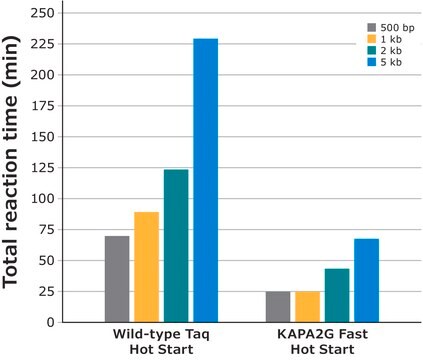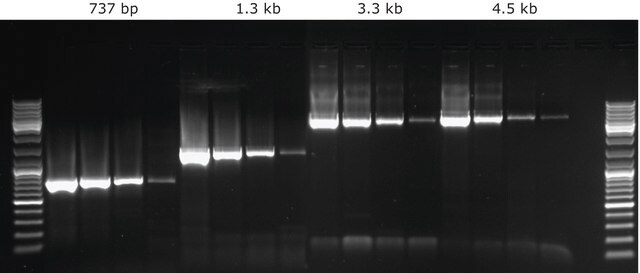2GRHSNTKB
Roche
KAPA2G Robust HotStart PCR Kit
with dNTPs
Synonym(s):
PCR, hotstart PCR
About This Item
Recommended Products
Quality Level
usage
sufficient for 1000 reactions
sufficient for 200 reactions
sufficient for 500 reactions
shelf life
≤12 mo.
feature
Difficult Templates/Specialty Enzymes PCR
dNTPs included
hotstart
packaging
pkg of 100 U (KK5532)
pkg of 250 U (KK5516)
pkg of 500 U (KK5518)
manufacturer/tradename
Roche
technique(s)
PCR: suitable
input
crude DNA
storage temp.
−20°C
Looking for similar products? Visit Product Comparison Guide
General description
Application
- Amplification of GC- or AT-rich templates
- Templates containing common PCR inhibitors e.g. salts, urea, SDS, or ethanol
- Crude sample PCR e.g. buccal swabs, cultured mammalian, yeast, or bacterial cells
- Colony PCR
- qPCR
- Nested polymerase chain reaction (PCR) amplification
- Amplification of DNA targets in PCR
- DNA amplification using conventional PCR
- Routine PCR
Biochem/physiol Actions
Features and Benefits
- Robust performance across a wide range of GC- and AT-rich templates
- Increased PCR success rates
Improved tolerance to common PCR inhibitors
- Efficient amplification from crude samples
- Higher yield and sensitivity per unit of enzyme
Unrivalled performance in colony PCR
- Higher yields and improved consistency of PCR direct from E. coli and yeast cells
Quick Notes:
- KAPA2G Robust HotStart® PCR Kits with dNTPs contain KAPA2G Robust HotStart DNA Polymerase, engineered for high processivity and inhibitor tolerance.
- Both purified genomic DNA and crude samples (e.g. colony PCR) can be used as template.
- Use 0.5 U of KAPA2G Robust HotStart DNA Polymerase per 25 μL reaction. More challenging PCRs (GCrich,crude sample) may require higher enzyme concentrations.
- Use 15 sec/kb extension time per cycle, and increase to 30-60 sec/kb for difficult amplicons or templates.
- KAPA2G Buffers contain 1.5 mM MgCl2 at 1X.
- Additional MgCl2 may be added using the 25 mM MgCl2 solution provided in the kit.
- KAPA2G Buffer A is optimized for high yield, specificity, and sensitivity.
- KAPA2G Buffer B is recommended for inhibitorcontaminated template samples.
- KAPA2G GC Buffer is recommended for GC-rich PCR (>70% GC).
- KAPA Enhancer 1 can be used with KAPA2G Buffer A or B, particularly for GC-rich assays.
- Reaction products are 3′-dA-tailed and may be cloned into TA cloning vectors.
Quality
Preparation Note
Other Notes
Legal Information
Kit Components Only
- KAPA2G Robust HotStart® DNA Polymerase 5 U/µL
- 5X KAPA2G Buffer A
- 5X KAPA2G Buffer B
- 5X KAPA2G GC Buffer
- 5X KAPA Enhancer 1
- KAPA MgCl2 25 mM
- KAPA dNTP Mix 10 mM each
Signal Word
Warning
Hazard Statements
Precautionary Statements
Hazard Classifications
Acute Tox. 4 Oral - Aquatic Chronic 3 - STOT SE 2
Storage Class Code
12 - Non Combustible Liquids
WGK
WGK 1
Flash Point(F)
does not flash
Flash Point(C)
does not flash
Certificates of Analysis (COA)
Search for Certificates of Analysis (COA) by entering the products Lot/Batch Number. Lot and Batch Numbers can be found on a product’s label following the words ‘Lot’ or ‘Batch’.
Already Own This Product?
Find documentation for the products that you have recently purchased in the Document Library.
Customers Also Viewed
Articles
An overview of directed evolution and the methods for generating proteins with optimized or entirely new functions.
Our team of scientists has experience in all areas of research including Life Science, Material Science, Chemical Synthesis, Chromatography, Analytical and many others.
Contact Technical Service






